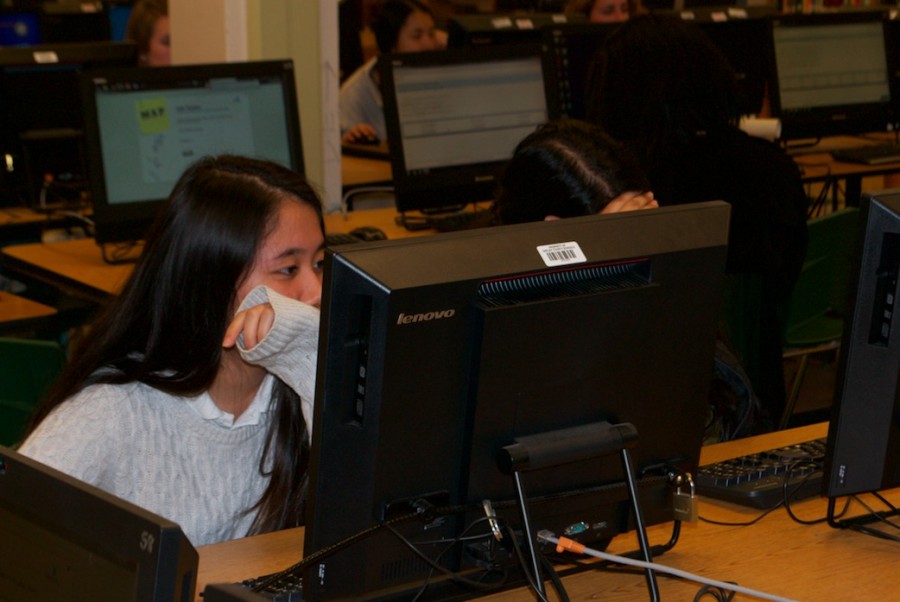Where does the MAP lead?
Kino Watanabe (11) taking the Map test.
SAT. ACT. ASVAB. CAT. EXPLORE. PSAT. NAEP. PLAN. TCAP. EOC.
The list goes on and on. You may not have heard of all of them, but you know what they are.
Standardized tests.
America has been giving these assessments to hopefuls for about a century, and in that time they have changed and adapted, but not necessarily for the better. Their use skyrocketed in 2002, when the No Child Left Behind Act was implemented. The NCLBA mandated annual testing in all 50 states in order to hold schools accountable for failing students.
Thirteen years later, Shelby County students are required to take at least 13 state mandated standardized tests, 11 of which are given to high school students, during the 2015-2016 school year, not including district mandated and in-class assessments.
“I think that the majority of [standardized tests] are irrelevant to the curriculum…They’re a waste of time and money. Nobody cares about them,” Erin Donlon (11) said.
This mentality has lent itself to the newly implemented Measures of Academic Progress test, which sparked controversy within the school as to its effectiveness, purpose and relevance.
The MAP test was designed to be an adaptive computerized software system that provides a personalized assessment for each student to precisely measure his or her proficiency level. Basically, the more questions a student answers right, the harder the test gets until the student’s proficiency is determined.
As a completely computerized system, the MAP allows for easily accessible data that students and educators can use to understand where students are academically. This data is then compared with the other measures put into place by schools and districts to craft a curriculum tailored to individual needs. The system seems to be foolproof, but it is not.
“I feel that they are trying to standardize us. If every kid becomes a standardized testing kid, then no one is going to do anything unique…They are trying to make us become [a] unit,” TaTyana Williams (11) said.
Unfortunately, the current system put into place by the SCS Board of Education hasn’t accounted for the MAP’s, or any standardized tests’, fatal flaw: time.
The amount of time spent taking these assessments, most recently, the MAP test, have left students wondering what the point is. A study done by the American Federation of Teachers shows that districts spend anywhere from 19 days to a little over a month preparing and testing students for various standardized tests.
“Usually we spend, like, most of time just testing and there’s not that much time for actual teaching, and weeks before that, [teachers] are just preparing us for testing,” Becca Folkes-Lolla (10) said.
Unfortunately, Folkes-Lolla may be correct.
This predicament sparked Abby Brittain (12) to dive just a little deeper into the mystery that is standardized testing. While researching, Brittain discovered approximately 46 hours of instruction was lost due to the recent block scheduling implemented for the MAP test. If testing continues as planned, with students taking the MAP at least twice more this year, approximately 138 hours of instructional time will be lost by the end of the year. This is the equivalent to the amount of time spent in one classroom of the course of the school year.
“I’m supposed to see my students five and a half hours per week on the regular schedule. If we were not testing and on a block schedule I should see them five. With testing I’m lucky if I see them three,” Adrien Alsobrook said.
In addition to the lost time, the block scheduling costs students during the actual test. Studies have shown that students have a short attention span, meaning even more time is lost. After about 15-45 minutes, most students “lose it” and tune out their teachers. Eventually, attention would return to the teacher, but it would only last in 4-5 minute spurts before students would once again lose interest. This amounts to students and teachers losing even more class time during the twice-as-long class periods block scheduling requires.
Why would the district implement a test that would result in the loss of so much instructional time? Put simply, because they had to.
“I would say there are valid concerns about the amount of testing going on with students and we will try to condense that as much as possible. This is certainly an unusual year for [the district]…Everybody is still learning. I think it is important to keep those things in mind [because] there are state requirements that we are going to have to meet,” SCS Director of Planning and Accountability William White said.
The district is required under the state Response to Instruction and Intervention Framework to implement a universal screener, the MAP test. This universal screener is one of the key parts of the RTI^2 Framework, which is meant to be a problem-solving model that allows for a learning environment that addresses individual student needs.
However, the flawless exterior of the RTI^2 Framework is nothing more than an illusion.
“The Tennessee Department of Education has given districts the option of not including test scores when calculating grades this school year. The district has not made a final decision on how to proceed” Director Assessment and Accountability Brant W. Riedel said.
Meaning, that students could be taking tests that will not only have no effect on the grades, but also will result in loss of crucial instructional time.
All in all, the MAP test has not only sparked concerns amongst the students and teachers but also proven itself to possibly be nothing more than an expensive waste of time.
Kino Watanabe (11) taking the MAP test.
Your donation will support the student journalists of White Station High School. Your contribution will allow us to purchase equipment and cover our annual website hosting costs.




































